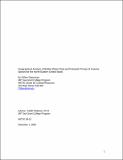| dc.contributor.author | Dassuncao, Clifton | |
| dc.date.accessioned | 2015-05-15T17:28:33Z | |
| dc.date.available | 2015-05-15T17:28:33Z | |
| dc.date.issued | 2008-12 | |
| dc.identifier.uri | http://hdl.handle.net/1721.1/97013 | |
| dc.description.abstract | The globalization of consumer goods and natural resources has led to an unintentional increase in exchanges of native biota (Bright 1999, Barbier and Shogren 2004, Perrings et al. 2005). Organisms that were once constrained to niche native environments are increasingly finding means of transporting themselves to new territories where lack of predation and ideal living conditions allow for geographic takeover. Ballast water discharge and hull fouling have been identified as the main vectors for these introductions (Ruiz et al. 1997, Molnar et al. 2008) which end up causing billions of dollars in economic damage (Pimentel et al. 2005) and invaluable ecological harm
(Gurevitch and Padilla 2004). | en_US |
| dc.language.iso | en_US | en_US |
| dc.publisher | Massachusetts Institute of Technology. Sea Grant College Program | en_US |
| dc.relation.ispartofseries | MIT Sea Grant Technical Reports;MITSG 08-51 | |
| dc.title | Geographical Analysis of Ballast Water Data and Potential Threats of Invasive Species for the North Eastern United States | en_US |
| dc.type | Technical Report | en_US |
